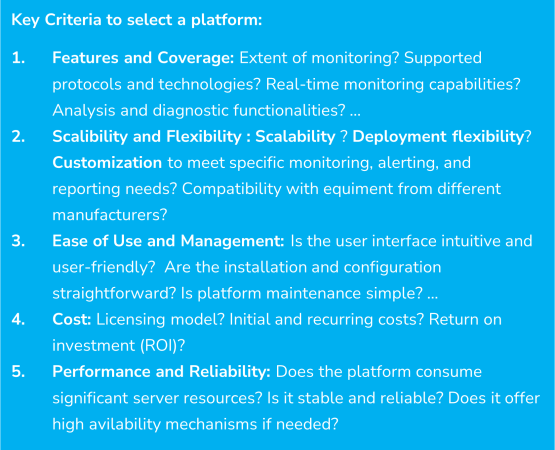In the ever-changing telecommunications landscape, network performance management platforms are emerging as crucial tools for ensuring optimal service quality, optimizing operations, and driving operator growth. Faced with an exponential increase in demand for connectivity, the rapid adoption of new technologies and high user expectations, telecom operators are encountering significant challenges that highlight the strategic importance of solid performance management.
Managing traffic growth and service diversification
Globally, data traffic is experiencing exponential growth, driven by an increasingly connected population, rising smartphone and fiber-to-the-home (FTTH) penetration, and the adoption of bandwidth-intensive services such as video streaming, online gaming, and social media applications. Additionally, the advent of 5G and the integration of the Internet of Things (IoT) significantly enhance network management.
 GSMA Intelligence study indicated that, in the Middle East and North Africa, mobile data traffic has increased by over 40% annually in recent years, while operators implementing artificial intelligence (AI)-based traffic allocation systems have observed a 15-20% reduction in network congestion during peak periods.
GSMA Intelligence study indicated that, in the Middle East and North Africa, mobile data traffic has increased by over 40% annually in recent years, while operators implementing artificial intelligence (AI)-based traffic allocation systems have observed a 15-20% reduction in network congestion during peak periods.
Network performance management platforms provide real-time visibility into network usage, enabling operators to anticipate traffic peaks, allocate resources through techniques like network slicing (similar to what Orange or Vodafone in Europe achieved on a 5G network), and ensure a seamless user experience (UX), even during periods of high demand.
They also facilitate quality-of-service (QoS) management for various service types. The integration of machine learning (ML) algorithms for traffic prediction allows for proactive resource allocation.
In another example, Saudi Telecom Company (stc) invested in a real-time traffic management platform that enabled them to respond to the massive increase in traffic during Hajj, ensuring a stable user experience for pilgrims. They reported a 30% improvement in customer satisfaction during the event.
Optimizing the customer experience and fostering user loyalty
In a highly competitive telecom market, customer experience quality is a key differentiator. Users, regardless of their geographical location, are increasingly demanding the following in terms of network performance: fast connection speeds, low latency, extensive coverage, and reliable service. Frequent interruptions, slow data rates, or poor coverage can lead to dissatisfaction and, sometimes, increased customer churn.
Accenture reported in one of its studies that a 10% improvement in the quality of the customer experience can translate into an 8-10% increase in revenues.
Enhancing operational efficiency and reducing costs
Managing mobile networks requires sophisticated tools to optimize operations and control expenses. Network performance management platforms centralize performance data from various sources (network equipment, probes, billing systems), providing a unified, near real-time, and holistic view of the network status. This centralization enables rapid problem detection, efficient incident resolution, and proactive capacity planning.
Additionally, automated monitoring and analysis allows engineering teams to focus on higher-value activities. A TM Forum study indicated that automating fault management processes with these platforms can lead to a 30-40% reduction in mean time-to-repair (MTTR).
For example, Zain (KSA) has implemented a performance management platform with automated root cause analysis capabilities, which has reduced network maintenance operating costs by 25%. Furthermore, operators utilizing predictive maintenance based on performance data analysis have reported a 15% reduction in equipment failures and have extended the network’s lifespan.
Facilitating the introduction and management of 5G and IoT
The deployment of 5G and the large-scale integration of IoT devices presents significant opportunities for operators. However, these new technologies introduce increased complexity in performance management.
Performance management platforms play a vital role in monitoring and optimizing 5G networks by measuring specific indicators for the different network slices. Ultra-low latencies or very high data rates can, thus, be achieved depending on the services offered and the slices configured on the network.
According to Ericsson, operators using advanced performance management platforms for 5G can achieve a 20% improvement in spectral efficiency and a 15% reduction in deployment and operational costs.
For IoT, these network performance management platforms provide essential end-to-end visibility to ensure application quality of service. Pioneering operators in IoT, such as du in the UAE, utilize specialized platforms to monitor connectivity and energy consumption of their smart meter deployments, enabling them to optimize IoT infrastructure management.
Ensuring security and regulatory compliance
Network and data security are major concerns for telecom operators and national regulators. Performance management platforms can incorporate security monitoring features, detecting anomalies and potential threats in real time. Additionally, they assist operators in complying with local regulations related to service quality, data protection, and reporting.
An IBM study estimated that the average cost of a data breach for telecommunications companies is several million dollars. These platforms, equipped with security monitoring capabilities, can help reduce detection and response times to security incidents, thereby minimizing costs and strengthening user trust in the operator.
How is this field evolving? AI, automation, observability
Innovations in mobile network performance management focus on integrating advanced technologies to address complex challenges. The use of artificial intelligence and machine learning enables predictive analysis and intelligent anomaly detection, facilitating proactive maintenance and automated network configuration optimization.
Meanwhile, automation and orchestration improve equipment provisioning and configuration, allowing for customizable workflows for repetitive tasks. Advanced observability, through enriched data collection and in-depth traffic analysis, provides increased visibility into performance and user experience.
Furthermore, platform integration and extensibility via open application programming interfaces (APIs) and microservices architectures promotes the unified management of hybrid and multi-cloud environments.
Finally, built-in security, bolstered by behavioral analysis and security tool integrations, enhances network protection while optimizing performance.
Key success factors for implementing a mobile network performance management platform
Implementing a network performance management platform is a complex project requiring rigorous planning, complete business and IT control, and careful execution to guarantee success. The following steps, combining preparation and stakeholder alignment, are necessary to successfully implement an effective and beneficial network performance management platform:
Clearly Defined Project and Cross-Team Collaboration
-
Strong management support is essential to secure necessary resources and overcome obstacles.
-
Involving network, security, application teams, and leadership from the start ensures buy-in, facilitates solution integration, and aligns objectives.
-
Precisely defining the technical and business goals of the platform is vital for selecting the right solution and measuring success.
Clearly Defined Project and Cross-Team Collaboration
-
Select a platform that matches your technical requirements, budget, and in-house expertise.
-
Align the solution’s features and capabilities with your organization’s specific needs, while considering your existing infrastructure, ease of use, scalability, cost, and reliability.

Rigorous Planning
-
A detailed project plan with clear milestones and defined responsibilities is essential for successful implementation.
-
Mobilize a multi-disciplinary team with strong networking and IT skills to install, configure, and use the platform.
-
Define a change management plan to ensure that platform users are properly trained and supported, that business processes are optimized, and that the platform is seamlessly integrated into your corporate environment.
Communication and Follow-Up
-
Keep all stakeholders informed of project progress and results.
-
Be prepared to adjust the plan according to feedback and challenges encountered.
-
Monitor defined key performance indicators (KPIs) to assess the platform’s impact and identify areas for improvement.
Sofrecom support: tailored and personalized regardless of the platform selected!
Sofrecom offers structured and comprehensive support for telecom operators, facilitating the adoption of network performance management platforms by focusing on several key areas:
-
Consulting: Our multidisciplinary experts assist operators in defining an adoption strategy for new platforms based on their challenges. This includes identifying priority use cases, aligning tools with business objectives, and planning implementation steps. With in-depth expertise, we guide operators in assessing their specific needs and developing tailored recommendations suited to their operational context.
-
Advanced Technical Support: Technical support at an expert level is essential for resolving complex issues that may arise with new platforms. We provide incident management assistance to ensure quick problem resolution. Additionally, our teams handle software updates and system maintenance to ensure proper functioning and compatibility with technological advancements.
-
Platform Integration Support: Sofrecom supports operators with deploying and configuring new platforms to ensure seamless integration with existing systems. We assist in integrating solutions with service management tools, security systems, and other existing infrastructures. This support helps minimize service disruptions and optimize performance from the outset.
-
Training and Change Management: Sofrecom offers tailored training programs to help operator teams acquire the skills needed to effectively use new technologies and selected platforms. Our change management consultants support technical and business teams to facilitate the adoption of new practices and improve collaboration across the network, security, and application teams. This approach ensures operators are well-prepared to utilize new platforms and fully leverage their capabilities.
At Sofrecom, we are committed to providing tailored support by offering strategic consulting, advanced technical support, effective integration of new platforms, and team training, while managing organizational change. This significantly enhances network performance and ensures the profitability of their investments.
Conclusion: a vital investment for the future of telecom
For telecom operators, adopting network performance management platforms is now a strategic imperative rather than an option. These platforms provide essential tools to navigate a complex and rapidly changing environment, meet rising user expectations, optimize operations, and ensure sustainable growth. Investing in robust and intelligent platforms is crucial to maintaining market leadership and ensuring sustainable growth.





